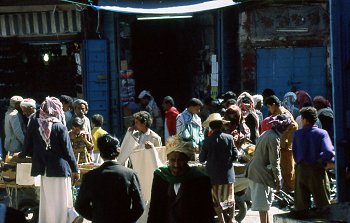home | internet service | web design | business directory | bulletin board | advertise | events calendar | contact | weather | cams

|
 A minaret rises above the sand streets of Sana'a. A minaret rises above the sand streets of Sana'a.Sana'a, Yemen Another “most foreign place in the world” is Old Sana’a, the capital of Yemen. Go back a thousand years in time to south Arabia, to a parched medieval city whose mud-brick buildings stand six and seven stories high, of mud-brick minarets, tall slender spires from which the muezzin sings out, or shrieks out, the call to prayer. All the streets are of deep sand. All the buildings are the color of sand. Only the window frames are painted, or rather smeared, white with gypsum. All else in Sana’a is the yellow-brown color of sand. After nightfall Sana’a becomes a totally different world, a world of darkness. The narrow streets and lanes turn shadowy and mysterious. There are no street lights as we know them, just an occasional light bulb dangling from a wire. Walking the streets, women in veils and men in turbans exude an atmosphere of dark mystery and intrigue. In the shadowy darkness I was trudging along a street of deep sand and rounded a corner. I jumped with startlement when I nearly bumped face to face into a man. In addition to the neck-to-ankle caftan and the turban wrapped around his head, he wore a large dagger thrust into the bulky sash around his waist. Then I quickly remembered that the dagger, the kanjar, is an essential part of a gentleman’s wearing apparel here in Yemen. In Oman, Yemen and all of south Arabia, a man is simply not dressed up unless he sports a silver-handled kanjar over his belly. It is the equivalent of wearing a necktie in the western countries. The sartorial dagger comes from a long tradition in Arabia where desert nomads fought over precious grazing land around the oases. The weapon was essential for survival in the desert. But today it is usually just a bejeweled reminder of the more violent centuries. In that shadowy lane I had not bumped into a sinister assassin, but merely a well-dressed Arab.
The next day while I was strolling along the crowded market street in Old Sana’a, the loud muezzin’s voice pierced the air from the tallest minaret at precisely twelve o’clock noon. The main street of sand was totally filled with men jostling each other along the shops. There were hundreds and hundreds of men, yet I did not see a single woman. Suddenly, at the call to prayer, the sea of bustling Arabs stopped and began flowing in the direction of the huge mosque. The mighty river of Muslims continued flowing into the mosque until the streets were completely empty. I just stood there alone in stunned amazement. Could you imagine any city in Europe or America where the entire urban population surged toward a house of prayer at midday? Could you imagine any city in Europe or America where the total population of the teeming streets were males? Not a single woman? Here at the southern tip of the Arabian peninsula where the Red Sea meets the Indian Ocean, to the enchanting city of Sana’a, the spirit of Tom Sawyer had summoned me like the muezzin’s call to prayer. December 1995
|
